Compagnie Marie Chouinard performs at Jacob’s Pillow, July 19 through 23
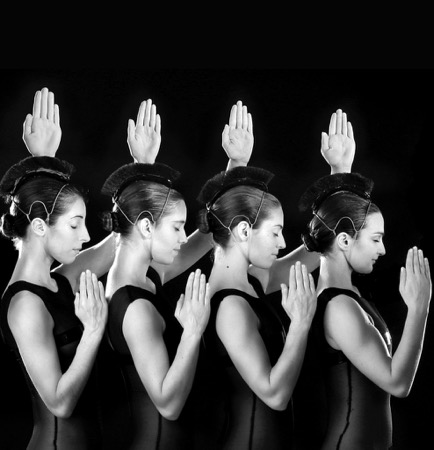
Marie Chouinard’s 24 Preludes by Chopin (an earlier cast). Photo: Marie Chouinard
The immaculately groomed women in the above photograph don’t look much like the dancers who took over the Ted Shawn Theater at Jacob’s Pillow to perform Marie Chouinard’s 24 Preludes by Chopin (1999). The six female members of her Montreal-based company still wear Liz Vandel’s translucent black leotards with what looks like strips of black tape censoring their breasts and pubes. However, beneath those coxcombs on their heads, their hair explodes into multiple pigtails and other experimentally frowsy coiffures. Morgane Le Tiec has even tied her locks into bunches with white rags. The mix of refinement and recklessness marks the choreography too.
Chouinard, a much-awarded, daring, and intriguing choreographer (and former dancer) founded Compagnie Marie Chouinard in 1990 (she is also the director of dance for the Venice Biennale). 24 Preludes is something of a rarity for her, in that she developed its choreography in relation to Chopin’s well-known piano music, while the other work on the program, Henri Michaux: Mouvements (2005-2011), was created—like many other pieces of hers—in silence and then fitted to its score, as is this one by Louis Dufour.
Watching 24 Preludes (with pianist Jean-François Latour part of the onstage picture), I can’t help occasionally thinking “eight more to go” or “is this the fifth section?”. But only occasionally, because Chouinard is adept at creating contrasts within what seems to be a guiding principle: her six sterling women and four men behave like members of a tribe—people who stick together both spatially and ideologically. Lined up, clumping, advancing in a pack, they give the impression that almost everything they do is a ritual, A man stands in one spot and stoically lifts a woman over and over and over, while she wriggles and lashes her arms and legs around. Valeria Galluccio (I believe it is she) claws Sacha Ouellette-Deguire’s long hair loose and yanks him along by it, and you can’t be sure whether this is a dramatic interlude or precludes an event you’d best not pause to contemplate.
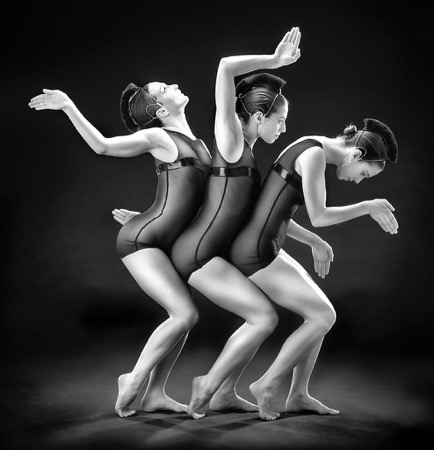
Three members of an earlier cast in Marie Chouinard’s 24 Preludes by Chopin. Photo: Marie Chouinard
These dancers are remarkably fluid. Watch any one of them cross the stage with deep, lunges, his/her torso undulating at every step. Their limbs are as mobile as their spines—whipping around, twisting in and out, organizing a competition among joint actions. In Mikhail Fokine’s 1904 Les Sylphides, a woodland spirit poises on pointe to listen for a bird call. When the same brief, questing Chopin prelude sounds in Chouinard’s world, a dancer whirls and crooks her arms and flutters her hands in a frenzy of motion. Yet the performers are also fiercely strong of leg: arched feet, legs beating together mid-air, you name it.
Since 24 Preludes is, in effect, a suite, continuity isn’t a given. In one scene, Carol Prieur tries to tell us something important in hasty not very loud French. Before she can finish, the horde marches in and, without noticing her, absorbs her as it travels. No matter how many times she returns, getting more and more urgent, the squad is always ready to enter and silence her. Yet in another vignette, a group kicks a ball around. There is no prevailing attitude either. Catherine Dagenais-Savard often has a little smile on her lips. Sébastien Cossette-Masse makes faces that reflect effort. Some of the dances end with Alex Morgenthaler’s imaginative lighting blacking out; at other times, one fades into one another. It’s as if we’re seeing a brochure of a civilization’s daily life, shaped by the moods, density, and speed of an aural landscape.
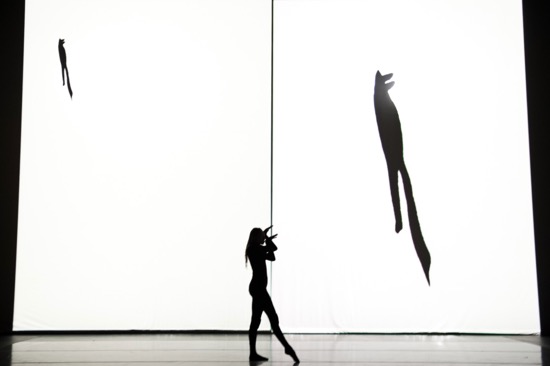
Carol Prieur and Henri Michaux’s drawings in Marie Chouinard’s Henri Michaux: Mouvements. Photo: Sylvie-Ann Pare
Henri Michaux: Mouvements began as a challenging game for the dancers and becomes one for us. The floor is white. The entire cyclorama is filled with a projection: a book’s pair of adjoining blank white pages. When the first black-clad dancer (Prieur) enters alone, one of the sixty-four India ink drawings in Michaux’s book is projected on the right-hand page, and, in a smaller size, at the top of the opposite one. She approximates the shape with her body. Each successive pose on the right is added to the left-hand display for each section. Another person takes her place. And another. . . .
At first, Michaux’s designs resemble the calligraphy of a primal language; some are easy to duplicate with the human body, others less so. So we watch with interest: how will the dancer before us manage to suggest that jagged edge, that blob, that loop? Sometimes a small, circular space made in a drawing seems to result in a dancer’s hands touching, finger to finger. At other times, it could be expressed by an open mouth; the several dancers who succeed one another to a grinding sound environment by Edward Freedman introduce their voices into the environment. Intermittently and at any point, an inhabitant may emit a growl or a cry.
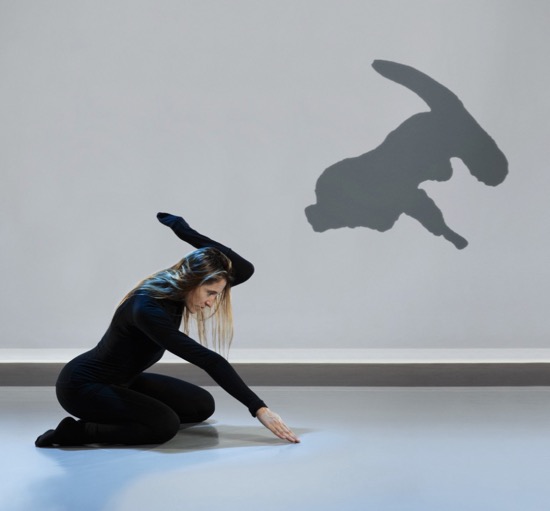
Carol Prieur and Henri Michaux’s drawing in Marie Chouinard’s Henri Michaux: Mouvements. Photo: Marie Chouinard
Before long, pairs collaborate on a drawing’s equivalent. Or bold trios. When more thin lines begin to trail and protrude from a shape’s core, no single dancer will suffice. For instance, Ouellette-Deguire carries on a squirming Charles Cardin-Bourbeau, four legs and two arms match one of Michaux’s spidery inked shapes. And at times a dancer may add a glove, a trailing sock, a stocking cap, or a strip of fabric to his/her black attire, in order to elongate it. Drawings fill both “pages” when all ten dancers (six women, four men) assemble on the stage, each of them channeling a different sketch. Interestingly, cast members wear no makeup for this piece, as if Chouinard wished to mute their individual glamor.
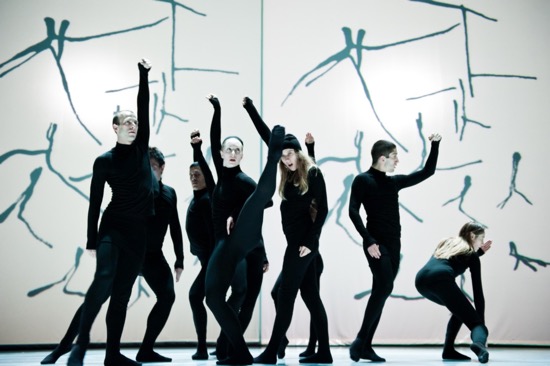
Cast members of Marie Chouinard’s Henri Michaux: Mouvements. Photo: Sylvie-Ann Pare
Michaux figures in another way too. Prieur rushes in with a microphone, pulls up one of the white floor panels and huddles, partly hidden under it. There she recites—fiercely and with increasing anguish— excerpts from Michaux’s 1951 poem “Mouvements.” He had not yet become a mescaline addict, but a kind of phantasmagorical drowning affects the writing. I kept hearing one word repeated many times in different contexts: “l’homme.” The English translation in the program reveals that the frenetic, gerund-rife text applies primarily to “man” alone. He’s the one “bracing,” “leaping,” and “hurtling.” But Michaux also links himself with others: “The stride now has the length of hope/ the leap has the length of thought / it has eight legs if we have to run/ it has ten arms if we join forces. . . .”
We have been warned that the performance includes strobe lights, and near the end of Henri Michaux: Mouvements, these begin to flash, exposing a small hurricane of white-clad figures dancing in blackness. The negative image to what we’ve been seeing? The humans freed from their design equivalents? Calligraphy erasing itself? It may be quixotic to pursue any such possibilities in relation to Chouinard’s fascinating work. However they have reminded me how vivid, smart, and accomplished these dancers are. I add these names to those aready mentioned: Scott McCabe, Motrya Kozbur, Clémentine Schindler.

this article about dance i really appreciate to blogger for this article. i am searching for this types blogs. this is very useful blogs. i already read this blogs its is really amazing.